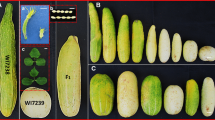Abstract
Cultivated tomatoes (Lycopersicon esculen- tum) encompass a wide range of fruit size and shape variants. This variation provides the basis for dissecting the genetic and molecular pathways of ovary and fruit development. One fruit shape variant is displayed by the cultivar Sun 1642 (TA491). TA491 has an elongated fruit phenotype, while the wild relative L. pimpinellifolium LA1589 produces fruit that are nearly perfect spheres, a shape typical of wild tomatoes. Developmental studies indicated that the differences in fruit shape between TA491 and LA1589 are determined by events occurring immediately after pollination and extending to 14 days post-pollination. Quantitative trait mapping revealed a single major locus on chromosome 7 (named sun) to be responsible for the differential development of TA491 and LA1589 fruit. Other fruit shape loci characterized in tomato (e.g. fs8.1 and ovate) exert their effects before anthesis and early in ovary development. sun is the first major locus identified in tomato controlling fruit shape through post-pollination events.
Similar content being viewed by others
Author information
Authors and Affiliations
Additional information
Received: 17 November 2000 / Accepted: 24 November 2000
Rights and permissions
About this article
Cite this article
van der Knaap, E., Tanksley, S. Identification and characterization of a novel locus controlling early fruit development in tomato. Theor Appl Genet 103, 353–358 (2001). https://doi.org/10.1007/s001220100623
Issue Date:
DOI: https://doi.org/10.1007/s001220100623




